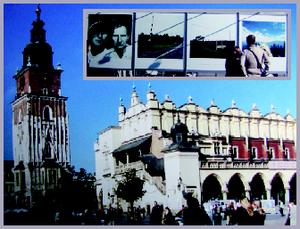

In the market square are the tower of the original town hall, left, and the Cloth Hall, both dating to the 14th century. INSET: Contemporary public art includes a photographic display called "Imago Mundi — image of the world, the world of images."
While Warsaw was almost completely leveled in World War II, Krakow - situated about 200 miles to the south - survived with little damage. (As the Nazis' headquarters in Poland, Krakow was spared early German destruction, and intended last-minute destruction plans by the retreating Nazis were thwarted by wiring that failed.) Good fortune that was because Krakow is home to Poland's oldest university and the home of royalty for ages. As Poland's national capital until 1596, it benefited from both sacred and secular building programs that created a city full of cathedrals, churches (more than 80 still exist), royal residences, and civic architecture. In 1978, Krakow was designated a World Heritage Site.
Market Square, called Rynek, has been the center of life in Krakow for more than 700 years. Ringed by churches and Medieval and Renaissance buildings of all sorts, it is one of the largest, if not the largest, existing Medieval squares in Europe. The size is deceiving because an enormous 14th-century Cloth Hall, a merchant's trading place - possibly the first shoppers' mall in the world - sits in the center of the large elegant plaza. Consequently, it is difficult visually to take in the expanse of the square.
From among a dozen important active churches on the square, we focused on St. Mary's Basilica, primarily because of its magnificent altarpiece. Created between 1477 and 1489 by German artist Veit Stoss, the High Altar dominates the interior. It can also dictate one's schedule if interested in seeing its cabinet-like structure opened each morning or closed after the last Mass each evening. The effort is well worth the couple of tries we made to see the back side of the closed wings depicting 12 scenes of Mary's suffering. The open cabinet depicts Mary's joys.
The exterior of St. Mary's is distinguished by dual asymmetrical towers. From the taller tower, a bugle call is played every hour, in remembrance of a warning of invaders played from the tower in 1241. A local told us the present-day buglers are firemen who pull 24-hour shifts because the climb up the tower is so arduous.
Just off the square down Florianska Street is a 14th-century gateway, topped off with a stunning Baroque roof. The street is home to open-air artists and vendors in front of beautiful townhouses with facades featuring old murals and inscriptions. One reads: "May this building stand until an ant drinks the ocean, and a tortoise circles the earth."
Just around the corner from the ancient gateway is the major museum draw in Poland. At the 18th-century Princes Czartoryski Museum are the two greatest paintings in Poland: "The Lady with an Ermine" by Leonardo Da Vinci (1452-1519) and "Landscape with the Good Samaritan" by Rembrandt (1606-1669). The latter work was on loan to the Netherlands in celebration of the master's birth 400 years ago, but "The Lady" was there in all her mystery. I could not help thinking had she remained in Paris, instead of purchased by a Polish prince as a gift for his mother, she might have been a major competitor to "Mona Lisa."
Haunting at The Princes are the empty frames scattered throughout the galleries with descriptions of lost art "confiscated by Nazis." Heartwarming is "Portrait of a Man Pulling on The Glove" by Jan Mostaert (1472-1555). Taken as war booty, it was auctioned in New York in 1948, given to the Virginia Museum of Fine Art, and restituted to Poland by VMFA in 2004.
Musically speaking, Poland's national hero and most recognized international piano composer is Fr?d?ric Chopin (1810-1849). Even though his father was French and he lived many years in France, Chopin was distinctively Polish, influenced by Polish folk tunes and the alternating emotional Polish states of mind, ranging from very romantic to the violent as in the defensive storms characteristic of Poland's warring history.
Our schedule did not permit an evening concert in Warsaw or at Chopin's birthplace in Zelazowa Wola about an hour west of Warsaw, but we were able to have a Chopin evening in Krakow on the exact date of his death, 157 years earlier. From among several offerings, we chose a "house concert" at the Polonia House, just off Market Square. The pianist, Mariusz Adamczak, was a recent winner of the distinctive Chopin competition, held every five years. Having played since the age of seven, this mid-career musician engaged his audience in a room that normally holds about 80. That special evening at least 100 were accommodated - seated up close and all around the piano. To call it a special concert is to understate the presentation of his all-Chopin program that included familiar selections before intermission and, appropriately, "B Flat Minor Sonata op.35," a famous funeral march, for the second half.
No visit to Krakow is complete without a visit to Wawel Hill, the ancient home to kings and national symbol of Poland's enduring strength and revitalized patriotism. Castle, treasury, armory, museums, and cathedral offer a study of architectural styles from Medieval to Baroque. Standing atop the hill, one has an unrivaled view of the Vistula River and an opportunity to contemplate the amazing cityscapes and picturesque bridges of Krakow.